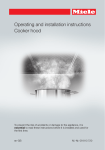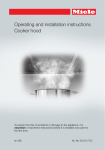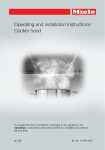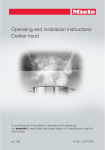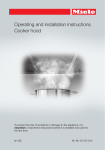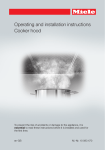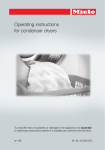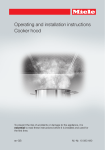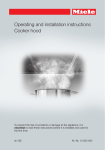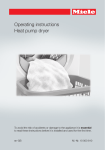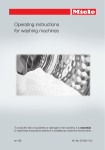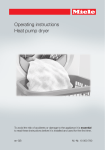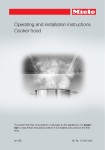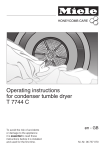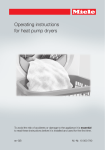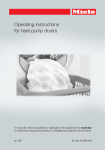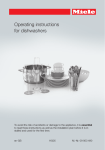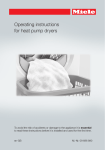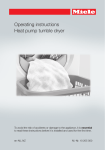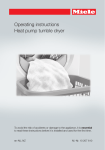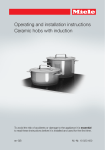Download Operating instructions Heat-pump dryer
Transcript
Operating instructions Heat-pump dryer To avoid the risk of accidents or damage to the appliance, it is essen‐ tial to read these instructions before it is installed and used for the first time. en-GB M.-Nr. 09 879 550 Caring for the environment Disposal of the packing mate‐ rial The packaging is designed to protect the appliance from damage during transportation. The packaging materials used are selected from materials which are environmentally friendly for disposal and should be recycled. Recycling the packaging reduces the use of raw materials in the manufactur‐ ing process and also reduces the amount of waste in landfill sites. Disposal of your old appliance Electrical and electronic appliances of‐ ten contain valuable materials. They al‐ so contain materials which, if handled or disposed of incorrectly, could be po‐ tentially hazardous to human health and to the environment. They are, however, essential for the correct functioning of your appliance. Please do not therefore dispose of it with your household waste. Please dispose of it at your local com‐ munity waste collection / recycling cen‐ tre. Ensure that it presents no danger to children while being stored for disposal. 2 Energy saving tips To avoid unnecessarily long drying times and high consumption of energy: – Make sure that your laundry is thor‐ oughly spun before drying. The high‐ er the spin, the greater the savings that can be made in energy and time during drying. – Load according to the optimum amount of laundry recommended for the programme being used. Under‐ loading is uneconomical. Overload‐ ing gives a poorer quality of drying and may cause unnecessary creas‐ ing. – Make sure the room temperature is not too high. If there are other heat producing appliances in the room in which the dryer is located, make sure the room is well ventilated and switch the other appliances off, if possible. – After every cycle remove the fluff from the surfaces of the fluff filters. Contents Caring for the environment .................................................................................. 2 Warning and Safety instructions ......................................................................... 5 Operating the tumble dryer................................................................................. 16 Control panel.......................................................................................................... 16 Before using for the first time................................................................................. 17 Laundry care......................................................................................................... 18 How to dry correctly ............................................................................................ 19 Brief instructions .................................................................................................... 19 Changing the programme sequence ................................................................. 21 Programme chart ................................................................................................. 22 Cleaning and care ................................................................................................ 25 Emptying the condensed water container ............................................................. 25 Make sure you clean all the filters at the correct intervals..................................... 26 Cleaning the fluff filters .......................................................................................... 27 Cleaning them whilst dry .................................................................................. 27 Cleaning them with water ................................................................................. 28 Replacing them................................................................................................. 28 Fine filter ................................................................................................................ 29 Removing the fine filter ..................................................................................... 29 Cleaning the fine filter ....................................................................................... 29 Cleaning the cover for the fine filter.................................................................. 30 Cleaning the heat exchanger ............................................................................ 30 Replacing .......................................................................................................... 31 Tumble dryer .......................................................................................................... 31 Problem solving guide ......................................................................................... 32 Check and fault messages .................................................................................... 32 Unsatisfactory drying results ................................................................................. 34 Other problems ...................................................................................................... 35 Changing the lamp................................................................................................. 37 After sales service ............................................................................................... 38 Repairs ................................................................................................................... 38 Optional accessories ............................................................................................. 38 Guarantee: U.K....................................................................................................... 38 Guarantee: Other countries.................................................................................... 38 3 Contents Installation and connection................................................................................. 39 Front view............................................................................................................... 39 Rear view ............................................................................................................... 40 Transporting the dryer............................................................................................ 40 Installation.............................................................................................................. 41 Building under a continuous worktop/in a row of kitchen units ....................... 41 Levelling the dryer............................................................................................. 42 Before moving the tumble dryer again (e.g. when moving house) ................... 42 Washer-dryer stack........................................................................................... 42 Electrical connection U.K....................................................................................... 43 Consumption data ............................................................................................... 44 Technical data ...................................................................................................... 45 Programmable functions..................................................................................... 47 Altering the residual moisture level in the Cottons programme ............................. 47 Altering the residual moisture level in the "Minimum iron" programme................. 48 Anti-crease............................................................................................................. 49 Switching the buzzer on/off ................................................................................... 50 Altering the standard drying level in the"Automatic plus" programme.................. 51 Standby.................................................................................................................. 52 Adjusting the dryer's electronics for very soft water ............................................. 54 4 Warning and Safety instructions It is essential to read these instructions. This tumble dryer complies with current safety requirements. Inap‐ propriate use can, however, lead to personal injury and damage to property. To avoid the risk of accidents and damage to the tumble dryer, please read these instructions carefully before using it for the first time. They contain important information on its safety, installation, use and maintenance. Keep these instructions in a safe place and ensure that new users are familiar with the content. Pass them on to any future owner. Correct application This tumble dryer is intended for use in domestic households and similar working and residential environments. This tumble dryer is not intended for outdoor use. It must be used only as a domestic appliance to dry items which have been washed in a water solution and which are marked on the manufacturer's care label as being suitable for tumble drying. If us‐ ing dry cleaning kits, do so at your own risk, and follow the instruc‐ tions provided on the packaging. Any other applications may be dangerous. Miele cannot be held lia‐ ble for damage resulting from incorrect or improper use or operation. 5 Warning and Safety instructions This tumble dryer can only be used by people with reduced physi‐ cal, sensory or mental capabilities, or lack of experience or knowl‐ edge, if they are supervised whilst using it or have been shown how to use it in a safe way and understand and recognise the conse‐ quences of incorrect operation. Safety with children Children under 8 years of age must be kept away from the tumble dryer unless they are constantly supervised. Children 8 years and older may only use the tumble dryer unsu‐ pervised if they have been shown how to use it safely and recognise and understand the consequences of incorrect operation. Children must not be allowed to clean or maintain the tumble dry‐ er unsupervised. Please supervise children in the vicinity of the tumble dryer and do not let them play with it. Technical safety Before setting up the tumble dryer, check it for any externally visi‐ ble damage. Do not install or use a damaged tumble dryer. Before connecting the tumble dryer, ensure that the connection data on the data plate (fuse rating, voltage and frequency) match the mains electricity supply. If in any doubt, consult a qualified electri‐ cian. Reliable and safe operation of this tumble dryer can only be as‐ sured if it has been connected to the mains electricity supply. 6 Warning and Safety instructions The electrical safety of this tumble dryer can only be guaranteed when correctly earthed. It is essential that this standard safety re‐ quirement is met. If in any doubt, please have the household wiring system tested by a qualified electrician. Miele cannot be held liable for the consequences of an inadequate earthing system (e.g. electric shock). Do not connect the appliance to the mains electricity supply by an extension lead, multi-socket adapter or similar. These can overheat and are a fire hazard. If the electrical connection cable is faulty it must only be replaced by a Miele authorised service technician to protect the user from danger. Unauthorised repairs could result in unforeseen dangers for the user, for which Miele cannot accept liability. Repairs should only be undertaken by a Miele approved service technician, otherwise any subsequent damage will not be covered by the guarantee. Faulty components must only be replaced by genuine Miele origi‐ nal spare parts. The manufacturer can only guarantee the safety of the appliance when Miele replacement parts are used. The tumble dryer must be isolated from the electricity supply in the event of a fault and during cleaning and maintenance. 7 Warning and Safety instructions This tumble dryer must not be used in a non-stationary location (e.g. on a ship). Do not make any alterations to the tumble dryer, unless author‐ ised to do so by Miele. Heat pump technology and refrigerant: The heat pump in this tumble dryer uses a refrigerant which is con‐ densed by the compressor and led in a closed circuit through the heat exchanger unit where heat exchange with the circulating drying air takes place. – The humming noises caused by the heat pump are normal and do not impair the efficient functioning of the dryer. – The refrigerant is not flammable or explosive. – In general it is not necessary to leave the dryer standing for any length of time before it is connected to the mains provided it has been transported and installed correctly (see "Installation and connection"). If it has not been transported as described, ensure that the rec‐ ommended standing time prior to first operation is observed. Oth‐ erwise the heat pump can be damaged. – This tumble dryer contains fluorinated greenhouse gases. They are hermetically sealed. Designation: R 134a 8 Warning and Safety instructions Please observe the instructions in "Installation and connection" and the "Technical data". The accessibility of the plug must always be ensured, in order to disconnect the tumble dryer from the mains. Do not block the gap between the bottom of the tumble dryer and the floor with plinth facings, deep pile carpet etc. This would hinder a sufficient flow of air to the dryer. Make sure the dryer door can be opened without hindrance after installation. Correct use The maximum load for this tumble dryer is 7.0 kg (dry weight). The maximum recommended loads for individual programmes are given in the Programme chart. To prevent the risk of fire, do not connect the tumble dryer via a controllable socket (e.g. a timer or a peak-load switch-off device). If the drying programme is interrupted before the end of the cooling down phase, this could cause the laundry to self-ignite. 9 Warning and Safety instructions To prevent the risk of fire, the following textiles must not be dried in this tumble dryer: – Items which have not been washed. – Items, such as workwear, which have not been thoroughly cleaned and which are still soiled with grease, oil or other depos‐ its (such as cosmetics, lotions etc). If items have not been thor‐ oughly cleaned there is a danger that these might ignite when heated, even after they have been removed from the dryer at the end of the programme. – Items (e.g. mops and floor cloths) which have been treated with inflammable cleaning agents or which contain residues of ace‐ tone, alcohol, benzene, petrol, kerosene, stain remover, turpen‐ tine, wax and wax remover or other chemicals. – Items which have been splashed with hair lacquer, hair spray, nail varnish remover or similar substances. When washing such heavily soiled items ensure that you use suffi‐ cient detergent and select a high temperature. If in doubt, wash the items several times. 10 Warning and Safety instructions Remove all items from pockets (e.g. lighters, matches). Warning: Do not switch the dryer off before the drying pro‐ gramme has finished. If this is done, the laundry must be hung up or spread out to cool it down. Fabric conditioner and similar products must be used according to the instructions on the manufacturer's packaging. To prevent the risk of fire, the following textiles must not be dried in this tumble dryer: – Items which have been cleaned using chemicals (e.g. professio‐ nal dry-cleaning agents). – Items which contain a large proportion of rubber, foam rubber or rubber-like materials. For example, products made from latex foam rubber, shower caps, waterproof textiles, rubberised articles and items of clothing and pillows with foam rubber filling. – Damaged items which contain padding or fillings (e.g. pillows, jackets). When damaged, the filling can get out with the risk of it igniting in the dryer. 11 Warning and Safety instructions In many programmes, the heating phase is followed by a cooling down phase to ensure that the items are not too hot to handle when you remove them (this also avoids the danger of the laundry self-ig‐ niting). The programme is not finished until the cooling down phase has been completed. As soon as the programme has finished, remove all laundry from the drum. Do not let anyone sit or lean on the door, as this can cause the tumble dryer to tip up. Always close the door after use. This way you will avoid the dan‐ ger of: – Children climbing onto or into the dryer or hiding things in it. – Pets or other small animals climbing into it. The tumble dryer must not be used without fluff filters or – with damaged fluff filters, or – with a damaged plinth filter. This would cause an excessive build-up of fluff which in turn would cause a fault. The fluff filters must be cleaned after every drying cycle. The fluff filters and the plinth filter must be thoroughly dried after cleaning. Do not replace them if they are damp or wet. Damp or wet filters could cause operational faults. Do not install the tumble dryer in a room where there is a risk of frost occurring. At temperatures around freezing point the tumble dryer may not be able to operate properly. There is a risk of damage if the condensed water is allowed to freeze in the pump and hoses. 12 Warning and Safety instructions If the water is drained externally through the drain hose instead of being collected in the condensed water container, make sure the drain hose is securely attached if you hang it in a sink or basin to avoid the hose slipping and the water causing damage. Condensed water is not drinking water. It can cause health problems in both people and animals if con‐ sumed. Always keep the area around the tumble dryer free of dust and fluff. Dust drawn into the tumble dryer can cause blockages in the heat exchanger over time. The tumble dryer must not be hosed down. 13 Warning and Safety instructions Using a fragrance flacon (optional accessory) Only use genuine Miele original fragrance flacons. The fragrance flacon must be stored in its packaging so please make sure you retain this. Caution. The fragrance can leak out of the flacon. Make sure that you always keep the flacon, or the fluff filter with the flacon inserted in it, in a horizontal position when carrying and do not tip or place down on any surface. Use an absorbent cloth to wipe up any fragrance which has leaked out of the flacon onto the floor, the dryer or any dryer compo‐ nents (e.g. the fluff filter) immediately. If fragrance which has leaked out of a flacon: comes into contact with the skin - wash the skin thoroughly with soap and water; comes in contact with the eyes - rinse the eyes with clean water for at least 15 minutes; is swallowed - rinse out the mouth thoroughly with clean water. Seek medical advice in the case of contact with the eyes or if fragrance has been swallowed. If fragrance which has leaked out of a flacon comes in contact with clothing, change the clothing immediately. Wash the clothing or any cloths used for mopping up fragrance thoroughly with plenty of water and detergent. There is the risk of fire or damage to the tumble dryer if the follow‐ ing instructions are not observed: – Never refill a flacon with fragrance. – Never use a faulty fragrance flacon. Dispose of an empty fragrance flacon with the household waste and never use it for any other purpose. Please also observe the information supplied with the fragrance flacon. 14 Warning and Safety instructions Accessories Only use genuine Miele original spare parts and accessories with this appliance. If non-Miele parts are used, guarantee, performance and product liability claims will be invalidated. The tumble dryer can be combined with a Miele washing machine in a washer-dryer stack. The appropriate "WTV" stacking kit (availa‐ ble to order) to match your tumble dryer and washing machine is re‐ quired. If you order a plinth for this tumble dryer (available from Miele as an optional accessory - depending on country), make sure it is the correct one. Miele cannot be held liable for damage caused by non-compli‐ ance with these Warning and Safety instructions. 15 Operating the tumble dryer Control panel a Display h min See the following page for more information. b Indicator lights See"Problem solving guide" The PC check light is also used by service technicians to run diagnostic checks on your tumble dryer and may be used to update programming data in the future. c Start button Press the Start button to start a programme The Start indicator light will flash as soon as the programme can be started. It lights up constantly once the programme has started. d Programme selector The programme selector can be turned clockwise or anti-clockwise. e On/Off button To switch the appliance on or off / to interrupt a programme. or the programme duration will light up as confirmation that the tumble dryer has been switched on. f Door button Pressing this button will open the door even when the appliance is not switch‐ ed on at the mains. 16 Operating the tumble dryer Display h min Drum lighting The display shows: If the dryer is switched on at the mains and the door is opened, the drum light‐ ing will come on. It will go out a few mi‐ nutes later to save energy. – the programme duration (h min = hours and minutes) – Check and fault messages – Settings The settings are used to tailor the dryer's electronics to suit your indi‐ vidual requirements. See "Settings" for more information. Estimated time remaining After the start of a programme the esti‐ mated programme duration will appear in the h min display in hours and mi‐ nutes (estimated time remaining). The only exception to this are the Timed drying programmes which last for 20 minutes. The estimated duration (time remaining) will appear in the display. The following factors all affect the estimated time re‐ maining: residual moisture content after spinning; type of fabric; size of load; room temperature; fluctuations in power supply. The electronics continually as‐ sess conditions in the appliance and adjust the estimated time remaining for a more accurate reading. Because of this, the time displayed can alter during the course of a programme. Pro‐ grammes can also finish earlier than ex‐ pected, if, for example, particularly fine fabric is being dried, the load is very small or items were partially dry before‐ hand. Before using for the first time Ensure that the dryer is installed and connected to the electricity sup‐ ply correctly. If the tumble dryer has not been transported as described in "Installation and connection" then it must be left to stand for at least 1 hour before it is connected to the electricity supply. 17 Laundry care Care symbols Drying / Normal/low temperature Drying is carried out at a low temperature in every pro‐ gramme in this dryer, so you do not need to sort your gar‐ ments according to whether they have the / symbol. Do not tumble dry Ironing Very hot Hot Warm Do not iron Tips on drying – Always observe the maximum rec‐ ommended loads given in the "Pro‐ gramme chart". Never overload the drum. Overloading can cause unnecessary wear and tear to the laundry, give a disappointing drying result and cause more creasing. – Open jackets so that they can dry evenly – Do not put soaking wet items into the tumble dryer to dry them; spin them thoroughly for at least 30 seconds af‐ ter washing. – Use the Automatic plus programme for drying mixed loads of cottons and minimum iron fabrics 18 – Pure linen should only be machine dried if specified as suitable by the manufacturer on the garment care la‐ bel, as the surface of the fabric may otherwise become rough. – Loopknit garments (e.g. T-shirts and underwear) tend to shrink depending on their quality. Do not over-dry these textiles. When purchasing these gar‐ ments it is advisable to take their shrinkage properties into account. – Minimum iron fabrics tend to crease more, the larger the load. This is also the case for garments made from very fine weave fabrics, such as shirts or blouses. Make sure you se‐ lect a suitable programme. If in doubt, divide the garments into smaller loads and select Gentle tum‐ ble or Gentle smoothing. – Starched laundry can be dried in the tumble dryer. To achieve the usual finish, double the amount of starch should be used. – New dark coloured garments should be washed and dried separately from light coloured garments to avoid the danger of colours running and disco‐ louring other garments or even plas‐ tic components in the dryer. Dark coloured fibres can also settle on light coloured garments and vice ver‐ sa. How to dry correctly Brief instructions Load the tumble dryer The headings numbered (, , ...) show the operating sequence and can be used as a brief guide to using your dryer. Press the Door button to open the door. Sort the laundry To ensure an even drying result sort laundry according to: . . . the drying level required . . . the type of fibre or weave . . . size . . . the moisture content after spinning. Make sure that objects e.g. de‐ tergent dispensing balls have been removed from the laundry. They could melt, and cause damage to the dryer or the laundry. Unfold the laundry and load loosely into the drum. Do not overload the drum. See the "Programme chart" for recommen‐ ded loads for each programme. Overloading can cause unnecessary wear and tear to the laundry and give a disappointing drying result. Before closing the door make sure the fluff filter is correctly positioned in the door. – Check seams and stitching to ensure that padding and linings are intact. – Fasten duvet covers, pillow cases etc. to prevent small items from be‐ ing rolled up inside them. – Fasten hooks and eyes. – Fasten any loose belts and ties – Underwiring and collar stiffeners: Any loose wiring in bras, shirt collar stiff‐ eners, etc. should be removed or sewn in. Turn on the tumble dryer The tumble dryer may be switched on after loading, saving energy as the light will not come on. Check the laundry is right inside the drum so that it cannot get trapped or damaged when the door is shut. Shut the door either with a gentle swing, or lean against it and push it shut. Switch the dryer on by pressing the On/Off button in. 19 How to dry correctly Select a programme Remove the laundry when the pro‐ gramme has finished There is a cooling down phase at the end of the drying sequence The pro‐ gramme is not finished until lights up and the buzzer sounds. Turn the programme selector clock‐ wise or anti-clockwise to the required programme. Start the programme. Press the Start button. The indicator light for the Start button will now light up constantly. Notes – The programme duration shown in the display is an estimation and can vary. – This dryer measures residual mois‐ ture content in the laundry to ensure perfect drying results. However, if dry laundry is loaded into the drum, it will be dried/aired for a set duration. Avoid overdrying items of laundry as these can become damaged. 20 The drum will continue to rotate at in‐ tervals for up to two hours to prevent laundry creasing, if you do not wish to remove it immediately (anti-crease phase). There is no anti-crease phase at the end of the Woollens programme. The duration of the cooling down phase is variable; see "Settings". Press the Door button. Open the door. Remove the laundry. Check that all items have been re‐ moved from the drum. If items are left in the dryer, they could be dam‐ aged by overdrying when the dryer is next used. Press the button to switch the dryer off. Clean the fluff filters Close the door. Empty the condensed water contain‐ er. Changing the programme sequence Once a programme has started Adding or removing laundry af‐ ter a programme has started ... changing the programme once it has started You cannot change to another pro‐ gramme once a programme has started (this prevents unintentional alterations). Restart the programme immedi‐ ately after adding or removing items. Otherwise remove all items and spread them out to cool down com‐ pletely. If you try to change a programme, lights up until the original programme is reset. Press the Door button. You will need to cancel the current pro‐ gramme before you can select a new one. Close the door. ... cancelling a programme Turn the programme selector to Fin‐ ish. The items will be cooled down, de‐ pending on the temperature reached and how long they have been dried for. Add or remove items. Press the Start button. Programme duration Altering the programme sequence can cause adjustments in the h min display. The programme is not finished until lights up. Switch the dryer off and then on again. Select and start a new programme immediately. 21 Programme chart Cottons Max. load: 7.0 kg* Normal+, Normal** Use for Single and multi-layered cotton fabrics such as towelling, jersey‐ wear, T-shirts, underwear, flannelette bed linen. Note: The Cottons normal programme is the most energy-efficient for drying cotton items with normal residual moisture levels. Normal - Gentle tumble Use for Items which are not suitable for drying with a great deal of mechani‐ cal action. When this option is selected the drum will rotate less fre‐ quently. Note: – The programme duration is longer than for the Normal drying lev‐ el. – If in doubt, reduce the size of the load. Hand iron, Machine iron Use for Cotton or linen fabrics requiring further processing, e.g.: table linen, bed linen, starched laundry. Note: To prevent laundry from drying out it should be rolled up until you are ready for ironing. * Weight of dry laundry ** Note for Test Institutes: Test programme in accordance with Regulation 392/2012/EU for energy labelling measured in accordance with EN 61121. 22 Programme chart Minimum iron Max. load: 3.5 kg* Normal, Hand iron Use for Minimum iron items made of cotton, synthetic or mixed fibre, e.g.: sweaters, shirts, blouses, skirts and table cloths. Note: In the Minimum iron programme with the Hand iron drying level, items are dried with very little creasing, depending on fabric type and amount of laundry. Normal - Gentle tumble Use for Items which are not suitable for drying with a great deal of mechani‐ cal action. When this option is selected the drum will rotate less fre‐ quently. Note: – The programme duration is longer than for the Normal drying lev‐ el. – If in doubt, reduce the size of the load. Automatic plus Use for Max. load: 3.5 kg* Mixed loads of garments suitable for the Cottons and Minimum iron programmes. Sort according to colour. Timed drying Max. load: 7.0 kg* 20 min warm air Use for – Multi-layered fabrics whose layers have different drying character‐ istics, e.g. jackets, pillows. – For drying individual items, e.g. bath towels, swimwear, tea-towels and small loads. 20 min cool air Use for Any item which only needs airing * Weight of dry laundry 23 Programme chart Gentle smoothing Use for Max. load: 1.0 kg* – Cotton and linen fabric – Minimum iron items made of cotton, synthetic or mixed fibre, e.g. trousers, jackets, shirts. Note: – Smooths out creasing caused during the spin cycle in the washing machine. – Items are not dried completely in this programme. – Remove items as soon as the programme has finished and leave to finish drying at room temperature. Woollens Max. load: 2.0 kg* Use for Woollen garments and fabrics containing wool blends, e.g. pull‐ overs, jackets. Note: – Wool and wool blend items are only fluffed up; they are not dried completely. – Remove garments as soon as the programme has finished and leave to finish drying at room temperature. * Weight of dry laundry 24 Cleaning and care Emptying the condensed water container The condensed water is collected in the condensed water container. Empty the condensed water contain‐ er after every drying programme. The Empty container indicator light will come on if the maximum level of the condensed water container is reached. The indicator light will go out when the door is opened and closed again when the tumble dryer is switched on. Empty the container. Replace the container in the dryer. Condensed water can cause health problems in people and ani‐ mals. Do not drink it. Condensed water can be put to house‐ hold use (e.g. used in a steam iron or humidifier). To ensure that any residual particles of fluff in the condensed water are removed before use, pass it through a fine sieve or paper filter first. Pull out the condensed water con‐ tainer. To prevent water running out, hold it at the front and towards the back and keep it in a horizontal position when carrying it. 25 Cleaning and care Make sure you clean all the fil‐ ters at the correct intervals This tumble dryer has a multistage filter system, consisting of the fluff filters in the door and the door opening and additional fine filters. When to clean the fluff filters Clean the fluff filters after each dry‐ ing programme – The dryer must not be used with‐ out the fluff filters or fine filter in place. – Make sure that the fluff filters and the fine filter are not damaged. Replace them immediately, if they are dam‐ aged in any way (available as option‐ al accessories). Failure to do so could cause an excessive build-up of fluff which in turn could cause a fault! The fluff which is created by the dry‐ ing process is collected by the fluff fil‐ ters in the door and the door opening. – See "Cleaning the fluff filters" When to clean the fine filter The fine filter only needs to be cleaned when the Clean out airways indicator light comes on. The fine filter is behind the service panel on the bottom left. It collects fi‐ ner fluff, hair and detergent residues which have got through the surfaces of the fluff filters in the door and the door opening. – See "Fine filter" 26 Cleaning and care Cleaning the fluff filters When to clean Clean the surfaces of the fluff filters in the door and the door opening af‐ ter each drying programme. Always check the fluff filters if the Clean out airways indicator light comes on. Cleaning them whilst dry Tip: You can use a vacuum cleaner to remove the fluff. 1 Fluff filter 2 Door seal Open the door and pull the fluff filter (1) out of the door as illustrated. Remove any fluff from the hollow part of the door with a bottle brush or a vacuum cleaner. Also clean the door seal (2) with a damp cloth. Use your fingers or a vacuum cleaner to remove the fluff from the surface of the filter. Use your fingers or a vacuum cleaner to remove the fluff from the two fluff filters in the door opening. Once clean, push the filter back into the door holder until it clicks into po‐ sition. Ensure it is facing the correct way. Close the door. 27 Cleaning and care Cleaning them with water Replacing them If there is a great deal of compacted fluff on any of the filters, they can be removed and cleaned with water. Do not replace them if they are damp or wet. Damp or wet filters could cause operational faults. Open the door and pull the fluff filter out of the door as described previ‐ ously. Push the large filter back into the door holder until it clicks into posi‐ tion. Ensure it is facing the correct way. The two filters in the door opening can also be removed if you need to clean them with water. Replace the filters in the door open‐ ing by first inserting them at the bot‐ tom and then pressing them into place at the top. Lock both dials (you will feel them click into position). Turn dial on the left and right fluff filter until you feel it click. Pull the filter out of the door opening by the dial as shown . Rinse all the filters under hot, running water. Dry the fluff filters thoroughly with care. Clean the area underneath the filters, e.g. with a vacuum cleaner. 28 Cleaning and care Fine filter When to clean The fine filter only needs to be cleaned when the Clean out airways indicator light comes on. The indicator light will go out when the door is opened and closed again. Removing the fine filter On the front left of the tumble dryer: Pull the filter out by the handle. Press to open the access panel for the fine filter (see arrow). Pull the handle out of the filter. The panel will spring open. Clean the fine filter thoroughly under running water. Cleaning the fine filter Then squeeze it thoroughly. It must not be replaced dripping wet as this can cause a fault. Use a damp cloth to remove any fluff from the handle 29 Cleaning and care Cleaning the cover for the fine filter Cleaning the heat exchanger Danger of injury. Do not touch the cooling fins. You could cut your‐ self. Prevent damage. Carefully pass the vacuum cleaner brush over the surface, without applying any pres‐ sure. Otherwise the cooling fins or the struts in front of them could be‐ come damaged. Use a damp cloth to remove any fluff. Make sure that you do not damage the rubber seal when doing this. Visible soiling: Check whether the cooling fins are blocked with fluff (as follows). Remove any visible soiling carefully with a vacuum cleaner using a dust‐ ing brush or a narrow crevice nozzle. 30 Cleaning and care Replacing The filter must be fitted correctly and the access panel closed to en‐ sure that water cannot leak from the condenser system and to ensure that the dryer functions efficiently. Tumble dryer Disconnect the tumble dryer from the mains electricity supply. Fit the filter back on the handle. Make sure it is the correct way round. To ensure that the filter is positioned correctly in the front of the heat ex‐ changer unit: Do not use solvents, abrasive cleaners, glass cleaners or multi-pur‐ pose cleaning agents. These could damage plastic surfaces and other parts. Clean the tumble dryer with a slightly damp cloth and a mild non-abrasive cleaning agent or a solution of wash‐ ing-up liquid and water. Clean the seal around the inside of the door with a damp cloth. Dry all parts with a soft cloth. First insert the handle with the filter attached over the two guide pins. The drum and other stainless steel parts can be cleaned with a suitable proprietary stainless steel cleaner fol‐ lowing the manufacturer's instruc‐ tions. Make sure that the yellow dot on the handle is on the right. Push the filter in completely Close the access panel. 31 Problem solving guide With the help of the following notes minor faults in the performance of the appli‐ ance, some of which may result from incorrect operation, can be put right without contacting the Service Department. Repair work to electrical appliances must only be carried out by a suitably qualified person in strict accordance with current local and national safety regu‐ lations. Repairs and other work by unqualified persons could be dangerous. The manufacturer cannot be held liable for unauthorised work. Check and fault messages Problem Cause and remedy The Empty container in‐ The condensed water container is full. dicator lights up. The Empty the container. programme is cancel‐ Open and close the door while the dryer is switch‐ led, ed on. The indicator light will go out. the buzzer sounds. The programme is can‐ celled. The buzzer may sound and the Clean out air‐ ways or Empty contain‐ er indicator flashes. 32 No obvious cause. Switch the dryer off and then on again. Start a programme. If the programme is cancelled again and a fault mes‐ sage appears, there is a fault. Contact Miele service. Problem solving guide Problem Cause and remedy The Start indicator light The dryer is in standby mode. This is a normal func‐ flashes slowly and the tion and does not indicate a fault. display is dark. See "Standby" in "Programmable functions". The Clean out airways indicator light comes on at the end of a pro‐ gramme. There is a build-up of fluff in the airways. Clean the fine filter. Clean the fluff filters Open and close the door while the dryer is switch‐ ed on. The indicator light will go out. The programme is can‐ celled and the Clean out airways indicator light comes on. An excessive amount of fluff has built up. Clean the fine filter, fluff filter and heat exchanger. Open and close the door while the dryer is switch‐ ed on. The indicator light will go out. Bars flash in the display The programme has finished but the laundry has not at the end of a pro‐ yet cooled down. gramme: Either remove the laundry and spread it out to cool ......... down or leave it in the tumble dryer to cool down during the cooling phase. lights up The programme selector has been moved. Select the original programme. The time remaining will appear in the display again. 33 Problem solving guide Unsatisfactory drying results Problem Cause and remedy The laundry is not suffi‐ The load consisted of different types of fabric. ciently dry Finish drying using the Warm air timed drying pro‐ gramme. Select a different programme next time. Tip: You can alter the drying levels for some pro‐ grammes (see "Programmable functions"). Laundry or feather filled The laundry was washed with insufficient detergent pillows smell after dry‐ Feathers are a natural product and this is quite nor‐ ing mal. Laundry: use sufficient detergent next time. Pillows: take out of the tumble dryer and air them. Use a fragrance flacon (available as an optional accessory) for your favourite fragrance. Items made of synthetic Synthetic fibres tend to attract static charge. fibres are charged with Static charge can be reduced by adding a fabric static electricity after conditioner to the final rinse in the washing pro‐ drying gramme. There is a build-up of fluff. Fluff is principally the result of friction when garments are being worn and to some extent when they are be‐ ing washed. Machine drying hardly causes any fluff to form and has no appreciable effect on the lifetime of the fabric. Fluff is collected by the fluff filters and fine filter and can be easily removed (see "Cleaning and care"). 34 Problem solving guide Other problems Problem Cause and remedy There are humming noises The compressor is operating. These noises are quite normal and do not indicate a fault. A programme does not start No obvious cause. Connect the tumble dryer to the mains Turn on the tumble dryer Close the door Check whether the mains fuse has tripped Has there been a power cut? When power is restored any previously running programme will restart auto‐ matically. The interior drum light‐ ing does not come on The lighting switches off automatically (to save ener‐ gy). Switch the dryer off and then on again. The lamp needs changing. Change the lamp as described at the end of this section. 35 Problem solving guide Problem Cause and remedy The drying process goes on too long or even switches off The temperature in the room may have risen sharply. Air the room to make sure that the temperature is not too high. Detergent residues, hair and fine fluff can clog the fluff filters and the fine filters The cooling ribs can be clogged up. Clean the fluff filters and the fine filters. Remove any visible fluff behind the panel in the heat exchanger cavity (see "Cleaning and care"). The cool air intake (bottom right grille) is blocked. Move any objects, such as a laundry basket, away from the grille. The fluff filters and the fine filter were still wet when they were replaced. The fluff filters and fine filter must be dry. The laundry has not been spun sufficiently. Make sure that your laundry is thoroughly spun at the appropriate spin speed in the washing ma‐ chine. The tumble dryer has been overloaded Do not exceed the maximum load for the pro‐ gramme selected. Metallic components, e.g. zips have prevented the dryer from registering the correct moisture level. Open the zips next time. If the problem occurs again, dry garments with long zips using the Warm air timed drying pro‐ gramme. * Before starting another programme: Switch the dryer off and then on again. 36 Problem solving guide Changing the lamp Disconnect the tumble dryer from the mains electricity supply. Open the door. You will find the interior lamp cover at the top of the drum aperture. Turn the lamp anti-clockwise to re‐ move. Replace the lamp. To close the cover push it upwards and press it on the left and right until you hear it click into position. Ensure that it is fitted into posi‐ tion securely, as any moisture could cause a short circuit. Insert a suitable tool* using light pres‐ sure under the side edge of the lamp cover as illustrated. * such as a wide flat bladed screwdriver Apply a little pressure and whilst do‐ ing so turn your wrist in the direction of the arrow to open the cover. The cover will open downwards. The temperature resistant lamp should only be ordered from your Miele dealer or the Miele Spare Parts Department. The lamp must be replaced with one of the same type and specifica‐ tion. The lamp specification and maximum wattage is stated on the data plate and on the lamp cover. 37 After sales service Repairs Dryer basket In the event of any faults which you cannot remedy yourself, please contact your Miele dealer or the Miele Service Department The dryer basket is suspended in the drum and does not rotate with the drum. This enables items which must not be subjected to mechanical action to be dried or aired. Contact details for Miele are given on the back cover of this manual. N.B. A call-out charge will be applied to serv‐ ice visits where the problem could have been resolved as described in these instructions. When contacting the Service Depart‐ ment, please quote the model and seri‐ al numbers both of which are located on the data plate (visible when the door is opened). Fragrance flacon A fragrance flacon can be used in your tumble dryer to add a pleasant fra‐ grance to your laundry. Guarantee: U.K. In the U.K. the appliance is guaranteed for 2 years from the date of purchase. However, you must activate your cover by calling 0330 160 6640 or registering online at www.miele.co.uk. Guarantee: Other countries For information on the appliance guar‐ antee specific to your country please contact Miele. See end of this booklet for contact details. Optional accessories Optional accessories for this tumble dryer are available from Miele, your Miele dealer or via the internet at: 38 Installation and connection Front view a Mains connection cable b Control panel c Condensed water container (empty after every drying pro‐ gramme) d Door (do not open during drying) e Access panel for the fine filter (do not open during drying) f Four height adjustable screw feet g Cool air intake grille (do not obstruct with a laundry bas‐ ket or other objects) 39 Installation and connection Rear view If transporting the dryer at an an‐ gle, only tip towards the left side. a Protruding lid for holding when mov‐ ing the dryer (see arrows) b Mains connection cable Transporting the dryer To manoeuvre the dryer out of its pack‐ ing case to its installation site, – hold it by the front feet – as well as by the edge of the lid where it protrudes to the rear of the dryer. Only transport the dryer as shown in the following illustrations. If the tumble dryer has not been transported as described, then it must be left to stand for at least 1 hour before it is connected to the electricity supply. Otherwise the heat pump can be damaged. 40 Installation and connection Installation Make sure the dryer door can be opened without hindrance after in‐ stallation. The cool air intake panel at the front of the dryer must not be blocked or covered, e.g. by a laun‐ dry basket, as this would cause a fault. Building under a continuous work‐ top/in a row of kitchen units It is very important to avoid a build-up of heat. The warm air which is expelled from the rear of the dryer must be able to dissipate. Warm air which cannot dissipate could cause a fault. N.B. When built under, drying times may be longer. A build-up of heat can be avoided by: – Adjusting the screw feet so that there is a gap of at least 20 mm between the floor and the bottom of the dryer. – Creating a gap for the dryer in the kitchen furniture plinth facing. – Creating ventilation gaps in the kitch‐ en unit. The dryer should not be installed next to a refrigeration appliance. The warm air expelled from the rear of the dryer would increase the temper‐ ature around the refrigeration appli‐ ance's heat exchanger causing the compressor to run continuously. If it is not possible to install the dryer anywhere else, then the refrigeration appliance must be sealed off from the dryer. Building under kits must only be installed/dismantled by a suitably qualified fitter. – A special building under conversion kit* with a cover plate to replace the appliance lid is required. It must be fitted by a suitably qualified fitter to ensure electrical safety. N.B. If there is space to push the tumble dryer un‐ der the worktop without removing the lid, the building under kit is not nec‐ essary. Otherwise it is essential. – Fitting instructions are supplied with the conversion kit. – The electrical socket must be located in an accessible position near the ap‐ pliance. With niche heights of: – 830-840 mm, longer screw feet* are required. – 870-885 / 915-930 mm, one or two raising kits* are required. *Miele accessory available to order 41 Installation and connection Levelling the dryer Before moving the tumble dryer again (e.g. when moving house) After each use a small quantity of con‐ densed water will collect in the area of the pump. This water can run out if the tumble dryer is tipped up when it is be‐ ing moved. It is a good idea to run the Warm air programme for approximately 1 minute before moving the tumble dry‐ er. Any remaining condensed water will then be fed into the condensed water container or out through the drain hose. The appliance must stand perfectly lev‐ el on all four feet to ensure safe and proper operation. Washer-dryer stack The tumble dryer can be combined with a Miele washing machine in a washerdryer stack. The appropriate "WTV" stacking kit* to match your dryer is re‐ quired. * Miele accessory available to order Stacking kits must only be in‐ stalled by a suitably qualified fitter. The screw feet can be adjusted to com‐ pensate for any unevenness in the floor. Do not block the gap between the bottom of the tumble dryer and the floor with plinth facings, deep pile carpet etc. This would hinder a sufficient flow of air to the dryer. 42 Installation and connection Electrical connection U.K. Non-rewireable plugs BS 1363 All electrical work should be carried out by a suitably qualified and competent person, in strict accordance with cur‐ rent national and local safety regula‐ tions (BS 7671 in the UK). The fuse cover must be refitted when changing the fuse, and if the fuse cover is lost, the plug must not be used until a suitable replacement is obtained. The colour of the correct replacement cover is that of the coloured insert in the base of the plug, or the colour that is em‐ bossed in words on the base of the plug (as applicable to the design of plug fitted). Ensure power is not supplied to the ap‐ pliance until after installation work has been carried out. The appliance is supplied with a mains cable with moulded plug ready for con‐ nection to a 230-240V mains supply. Please ensure the connection data quo‐ ted on the data plate match the house‐ hold mains supply. Replacement fuses should be ASTA ap‐ proved to BS 1362 and have the cor‐ rect rating. Replacement fuses and fuse covers may be purchased from your lo‐ cal electrical supplier. Connection should be made via a suita‐ ble switched socket which is easily ac‐ cessible after installation. WARNING: THIS APPLIANCE MUST BE EARTHED For extra safety it is advisable to protect the appliance with a suitable residual current device (RCD). Contact a quali‐ fied electrician for advice. Do not connect via an extension lead. Extension leads do not guarantee the required safety of the appliance (e.g. danger of overheating). 43 Consumption data Load1 Final spin speed in a domestic washing machine Residual moisture Energy Duration kg rpm % kWh min 7.0 1000 60 2.09 144 3.5 1000 60 1.22 88 7.0 1200 53 1.85 130 7.0 1400 50 1.80 124 7.0 1600 44 1.60 110 Cottons Normal, Gentle tumble 7.0 1000 60 2.04 147 Cottons Hand iron 7.0 1000 60 1.56 108 7.0 1200 53 1.35 95 7.0 1400 50 1.25 88 Cottons Normal2 Cottons Normal 7.0 1600 44 1.10 75 Minimum iron Normal 3.5 1200 40 0.75 54 Minimum iron Normal, Gentle tumble 3.5 1200 40 0.70 56 Minimum iron Hand iron 3.5 1200 40 0.65 47 Automatic plus 3.5 800 50 1.34 96 1 Weight of dry laundry 2 Test programme in accordance with Regulation 392/2012/EU for energy labelling measured in ac‐ cordance with EN 61121 All data was calculated using EN 61121 unless otherwise stated. Power consumption when switched off Power consumption when not switched off 0.15 W 3.50 W Note for test institutes: For testing in accordance with EN 61121, dry a 3 kg load of cotton laundry with 70% residual moisture as per the above standard using the Cottons Normal programme. Consumption data can vary from the nominal values given above depending on the size of the load, types of textiles, residual moisture levels after spinning and fluctuations in the electricity supply. 44 Technical data Height 850 mm Width 595 mm Depth 596 mm Depth with door open 1071 mm Height for building under 820 mm Width for building under 600 mm Depth for building under 600 mm Suitable for pushing under a worktop Yes Suitable for stacking Yes Weight 60.5 kg Drum volume 111 litres Load size 1-7 kg dry weight Capacity of condensed water container 4.2 l Length of connection cable 2.00 m Voltage See data plate Power rating See data plate Fuse rating See data plate Lamp wattage See data plate Test certificates awarded See data plate 45 Programmable functions Various settings can be reprogrammed to alter the dryer's electronics to suit different requirements. They can be altered at any time. 46 Programmable functions Altering the residual moisture level in the Cottons pro‐ gramme The tumble dryer is designed to dry effectively using as little energy as possible. However, if you require the laundry to be drier or damper, you can reduce or increase the default residual moisture in this programme. Exception: The Normal drying level re‐ mains unchanged. Follow steps (,, ...) to pro‐ gramme and store in memory. Before you begin, ensure that: – The tumble dryer is switched off. – The door is closed. The option selected will be displayed by a number which will alternate with . Laundry will be damper Factory default setting (The Clean out airways indicator light will also flash once) Laundry will be drier (The Clean out airways indicator light will also flash twice) Pressing the Start button switches between the options. Switch the dryer off. The setting you have selected is now stored in memory. You can change it again at any time. – The programme selector is pointing to Finish. To check the setting: Press Start and keep it pressed in whilst carrying out steps -. Switch the dryer off after checking. Carry out steps -. Switch the dryer on. Wait until the indicator light for the Start button lights up constantly . . . . . . and then release the Start but‐ ton. The Empty container indicator light will flash once. 47 Programmable functions Altering the residual moisture level in the "Minimum iron" programme The tumble dryer is designed to dry effectively using as little energy as possible. However, if you require the laundry to be drier or damper, you can reduce or increase the default residual moisture in this programme. Follow steps (,, ...) to pro‐ gramme and store in memory. The option selected will be displayed by a number which will alternate with . Laundry will be damper Factory default setting (The Clean out airways indicator light will also flash once) Laundry will be drier (The Clean out airways indicator light will also flash twice) Before you begin, ensure that: Pressing the Start button switches between the options. – The tumble dryer is switched off. Switch the dryer off. – The door is closed. The setting you have selected is now stored in memory. You can change it again at any time. – The programme selector is pointing to Finish. Press Start and keep it pressed in whilst carrying out steps -. To check the setting: Switch the dryer on. Switch the dryer off after checking. Wait until the indicator light for the Start button lights up constantly . . . . . . and then release the Start but‐ ton. Turn the programme selector to Cot‐ tons Normal+. The Empty container indicator light will flash twice. 48 Carry out steps -. Programmable functions Anti-crease Helps prevent creasing, if laundry is not normally removed immediately af‐ ter the end of a programme. The drum rotates at intervals for 2 hours after the end of a programme. The anti-crease function The option selected will be displayed by a number which will alternate with . Anti-crease action off Anti-crease 1 h) (The Clean out airways will also flash once) – is activated when the tumble dryer is delivered. You can shorten the dura‐ tion of the anti-crease phase or de‐ activate it if wished. Anti-crease 2 h (factory default set‐ ting (The Clean out airways will also flash twice) – can be used for all programmes, ex‐ cept Woollens handcare. Pressing the Start button switches between the options. – should always be switched on. Switch the dryer off. Follow steps (,, ...) to pro‐ gramme and store in memory. The setting you have selected is now stored in memory. You can change it again at any time. Before you begin, ensure that: – The tumble dryer is switched off. – The door is closed. – The programme selector is pointing to Finish. To check the setting: Carry out steps -. Switch the dryer off after checking. Press Start and keep it pressed in whilst carrying out steps -. Switch the dryer on. Wait until the indicator light for the Start button lights up constantly . . . . . . and then release the Start but‐ ton. Turn the programme selector to Cot‐ tons Normal . The Empty container indicator light will flash three times. 49 Programmable functions Switching the buzzer on/off A buzzer sounds (at intervals for a maximum of 1 hr) to let you know the programme has finished. The option selected will be displayed by a number which will alternate with . Buzzer off Buzzer on (Factory default setting) (The Clean out airways indicator light will also flash once). The dryer is delivered with the buzzer switched on, but you can switch it off if you wish. The buzzer will still sound if there is a fault, even if it has been switched off. Pressing the Start button switches between the options. Follow steps (,, ...) to pro‐ gramme and store in memory. Switch the dryer off. Before you begin, ensure that: – The tumble dryer is switched off. – The door is closed. – The programme selector is pointing to Finish. Press Start and keep it pressed in whilst carrying out steps -. Switch the dryer on. Wait until the indicator light for the Start button lights up constantly . . . . . . and then release the Start but‐ ton. Turn the programme selector to Cot‐ tons Gentle tumble. The Empty container indicator light will flash four times. 50 The setting you have selected is now stored in memory. You can change it again at any time. To check the setting: Carry out steps -. Switch the dryer off after checking. Programmable functions Altering the standard drying level in the"Automatic plus" programme The drying level for this programme is set to the standard Normal level. You have the option of changing the drying level to Hand iron (damper than Nor‐ mal) or to Normal+ (drier than Normal). Follow steps (,, ...) to pro‐ gramme and store in memory. Before you begin, ensure that: – The tumble dryer is switched off. – The door is closed. – The programme selector is pointing to Finish. Press Start and keep it pressed in whilst carrying out steps -. Switch the dryer on. Wait until the indicator light for the Start button lights up constantly . . . The option selected will be displayed by a number which will alternate with . Standard setting - Hand iron Factory default setting (The Clean out airways indicator light will also flash once) Standard setting will be Normal+ (The Clean out airways indicator light will also flash twice) Pressing the Start button switches between the options. Switch the dryer off. The setting you have selected is now stored in memory. You can change it again at any time. To check the setting: Carry out steps -. Switch the dryer off after checking. . . . and then release the Start but‐ ton. Turn the programme selector to Cot‐ tons Hand iron. The Empty container indicator light will flash six times. 51 Programmable functions Standby To save energy, the display goes out after 10 minutes and the indicator light for the Start button starts flashing slowly. Not in current programme (factory default setting) As described under "On". However, indicator lights will stay on when the programme has started and remain visible during the programme. To come out of Standby mode: Off Move the programme selector or press Start. Neither will have any ef‐ fect if a programme is running. Indicator lights will stay on while the dryer is switched on. On Follow steps (,, ...) to pro‐ gramme and store in memory. Standby function is activated and the indicator lights will go out after 10 mi‐ nutes: Before you begin, ensure that: – if a programme is not selected after the dryer has been switched on. – The door is closed. – after a programme has started. They will, however come on for 10 mi‐ nutes at the end of the programme or the end of the anti-crease phase. The buzzer (if selected) will sound for 10 mi‐ nutes at the end of the programme. – The tumble dryer is switched off. – The programme selector is pointing to Finish. Press Start and keep it pressed in whilst carrying out steps -. Switch the dryer on. Wait until the indicator light for the Start button lights up constantly . . . . . . and then release the Start but‐ ton. Turn the programme selector to Cot‐ tons Machine iron. The Empty container indicator light will flash eight times. 52 Programmable functions The option selected will be displayed by a number which will alternate with . On Not in current programme (factory default setting) (The Clean out airways indicator light will also flash once) Off (The Clean out airways indicator light will also flash twice) Pressing the Start button switches between the options. Switch the dryer off. The setting you have selected is now stored in memory. You can change it again at any time. To check the setting: Carry out steps -. Switch the dryer off after checking. 53 Programmable functions Adjusting the dryer's electron‐ ics for very soft water The Empty container indicator light will flash on and off slowly once and then on and off quickly twice. This setting should only be al‐ tered if the water is so soft that it is likely to cause the electronics which sense residual moisture in the laun‐ dry to give false readings. The option selected will be displayed by a number which will alternate with . Factory default setting Adjusted for very soft water (with low conductivity) (The Clean out airways indicator light will also flash once) Important If the dryer is installed in an area with very soft water, you should contact your local water supplier for information and advice regarding water hardness and water conductivity. If the water conductivity is less than 150 μS, the fol‐ lowing setting will need to be activated. Pressing the Start button switches between the options. Only activate this setting if these conditions are present. Otherwise drying results will be unsatisfactory. Follow steps (,, ...) to pro‐ gramme and store in memory. Before you begin, ensure that: – The tumble dryer is switched off. – The door is closed. – The programme selector is pointing to Finish. Press Start and keep it pressed in whilst carrying out steps -. Switch the dryer on. Wait until the indicator light for the Start button lights up constantly . . . . . . and then release the Start but‐ ton. Turn the programme selector to Gen‐ tle smoothing. 54 Switch the dryer off. The setting you have selected is now stored in memory. You can change it again at any time. To check the setting: Carry out steps -. Switch the dryer off after checking. United Kingdom Miele Co. Ltd. Fairacres, Marcham Road Abingdon, Oxon, OX14 1TW Customer Contact Centre Tel: 0330 160 6600 E-mail: [email protected] Internet: www.miele.co.uk Australia Miele Australia Pty. Ltd. ACN 005 635 398 ABN 96 005 635 398 1 Gilbert Park Drive, Knoxfield, VIC 3180 Tel: 1300 464 353 Internet: www.miele.com.au China Miele (Shanghai) Trading Ltd. 1-3 Floor, No. 82 Shi Men Yi Road Jing' an District 200040 Shanghai, PRC Tel: +86 21 6157 3500, Fax: +86 21 6157 3511 E-mail: [email protected], Internet: www.miele.cn Miele (Hong Kong) Limited 41/F - 4101, Manhattan Place 23 Wang Tai Road Kowloon Bay, Hong Kong Tel: (852) 2610 1331, Fax: (852)2610 1013 Email: [email protected] India Miele India Pvt. Ltd. Ground Floor, Copia Corporate Suites Plot No. 9, Jasola New Delhi - 110025 Tel: 011-46 900 000, Fax: 011-46 900 001 E-mail: [email protected], Internet: www.miele.in Ireland Miele Ireland Ltd. 2024 Bianconi Avenue Citywest Business Campus, Dublin 24 Tel: (01) 461 07 10, Fax: (01) 461 07 97 E-Mail: [email protected], Internet: www.miele.ie Manufacturer: Miele & Cie. KG Carl-Miele-Straße 29, 33332 Gütersloh, Germany 55 Malaysia Miele Sdn Bhd Suite 12-2, Level 12 Menara Sapura Kencana Petroleum Solaris Dutamas No. 1, Jalan Dutamas 1 50480 Kuala Lumpur, Malaysia Phone: +603-6209-0288 Fax: +603-6205-3768 New Zealand Miele New Zealand Limited IRD 98 463 631 Level 2, 10 College Hill Freemans Bay, Auckland 1011, NZ Tel: 0800 464 353 Internet: www.miele.co.nz Singapore Miele Pte. Ltd. 163 Penang Road # 04 - 03 Winsland House II Singapore 238463 Tel: +65 6735 1191, Fax: +65 6735 1161 E-Mail: [email protected] Internet: www.miele.sg South Africa Miele (Pty) Ltd 63 Peter Place, Bryanston 2194 P.O. Box 69434, Bryanston 2021 Tel: (011) 875 9000, Fax: (011) 875 9035 E-mail: [email protected] Internet: www.miele.co.za United Arab Emirates Miele Appliances Ltd. P.O. Box 11 47 82 Gold & Diamond Park, Sheikh Zayed Road Building 6 / Offices Nos. 6-214 to 6-220 Dubai Tel: +971-4-341 84 44 Fax: +971-4-341 88 52 E-Mail: [email protected] Internet: www.miele.ae T 8164 WP en-GB M.-Nr. 09 879 550 / 03
























































